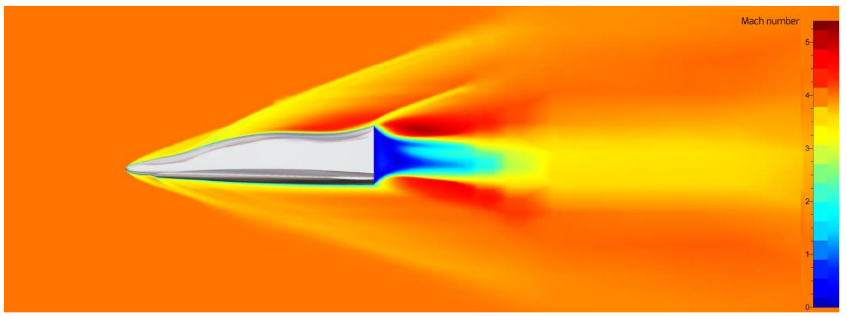Introduction

In the high-stakes world of military aviation, precision and performance are paramount. The aerodynamic behavior of missiles and fighter jets is subjected to extreme conditions, with aerodynamic heating being a critical factor. In this article, we delve into the fascinating realm of Computational Fluid Dynamics (CFD) analysis, specifically focusing on how it aids in understanding and mitigating aerodynamic heating in these high-speed machines.
Aerodynamic Heating: The Crucial Challenge

When missiles or fighter jets hurtle through the atmosphere at supersonic speeds, they face an intense aerodynamic environment. The friction and compression of air molecules generate immense heat, potentially reaching temperatures that can compromise the structural integrity of the vehicle. This section sheds light on the physics behind aerodynamic heating and its implications for aerospace engineers.
● Understanding Aerodynamic Heating: Key Concepts and Effects
● Strategies for Mitigating Aerodynamic Heating in Aerospace Design
● Materials and Coatings: Crucial Aspects in Heat-resistant Aerospace Structures
● Innovations in Thermal Protection Systems to Tackle Aerodynamic Heating
● Case Studies: Successful Approaches in Overcoming Aerodynamic Heating Challenges
● Future Trends: Advancements in Aerodynamic Heating Management Techniques
● Expert Insights: Engineering Solutions for Optimal Aerodynamic Heating Control
● Importance of Computational Fluid Dynamics (CFD) in Aerodynamic Heating Analysis
● Balancing Performance and Thermal Protection: Critical Considerations for Engineers
● Regulatory Compliance and Safety Measures in Addressing Aerodynamic Heating Issues.
CFD’s Role: Simulating Extreme Conditions
Traditionally, studying aerodynamic heating required expensive and time-consuming wind tunnel tests. CFD revolutionizes this process by allowing engineers to simulate the aerodynamic behavior of missiles and fighters under various conditions. This section explains how CFD models the complex interplay between airflow, surface materials, and heat transfer, providing invaluable insights into aerodynamic heating effects.
Aerodynamic Heating Mitigation Strategies
Engineers employ ingenious strategies to protect missiles and fighter jets from the ravages of aerodynamic heating. Advanced materials, thermal protection systems, and innovative design techniques are at the forefront of these efforts. This section delves into the cutting-edge methods employed to ensure that aerospace vehicles can withstand the extreme temperatures encountered during flight.
● Thermal Protection Systems: Shielding against High Temperatures during Reentry
● Heat-Resistant Materials: Alloys, Ceramics, and Composite Solutions
● Active Cooling Techniques: Managing Heat with Cryogenic Liquids or Gases
● Passive Cooling Methods: Radiative and Ablative Heat Shielding Mechanisms
● Thermal Coatings: Advanced Surface Treatments for Temperature Regulation
● Shape Optimization: Reducing Drag and Heat Generation through Aerodynamic Design
● Boundary Layer Control: Enhancing Heat Dissipation through Flow Manipulation
● Multi-Layered Approaches: Combining Materials and Techniques for Maximum Efficiency
● Computational Simulations: Using CFD to Predict and Analyze Aerodynamic Heating
● Testing and Validation: Wind Tunnel Experiments and Real-world Validation of Mitigation Strategies.
Shock Waves and Thermal Management
Supersonic and hypersonic flight introduce additional challenges in the form of shock waves. These powerful waves of compressed air generate intense heat, demanding sophisticated thermal management systems. We explore how CFD aids in understanding and mitigating the
effects of shock waves on aerodynamic heating, ensuring the safety and performance of high-speed aerospace vehicles.
● Understanding Shock Waves: Phenomena in High-Speed Fluid Dynamics
● The Role of Shock Waves in Aerospace and High-Speed Transport
● Thermal Challenges: Managing Heat Generated by Shock Wave Interactions
● Material Considerations: Heat-Resistant Solutions in Shock Wave Environments
● Computational Tools: Utilizing CFD for Predicting Shock Wave Effects
● Aerodynamic Design for Shock Wave Minimization and Heat Dissipation
● Innovative Cooling Techniques: Thermal Management Strategies in Aerospace
● Case Studies: Successful Approaches in Shock Wave Mitigation and Cooling
● Future Trends: Advancements in Material Science for Enhanced Thermal Protection
● Interdisciplinary Approaches: Collaborative Efforts in Shock Wave Research and Thermal Engineering.
Future Frontiers: Hypersonic Technology and CFD
As the aerospace industry pushes the boundaries of speed with hypersonic technology, CFD’s role becomes even more critical. Hypersonic flight introduces new complexities, including extreme temperatures and shock wave interactions. This section provides a glimpse into how CFD is being leveraged to pioneer the next generation of high-speed aviation.
Conclusion: Empowering High-Speed Flight with CFD
The marriage of CFD analysis and aerospace engineering has unlocked a new era of
understanding and innovation. By harnessing the power of simulation, engineers can tackle the
formidable challenges of aerodynamic heating in missiles and fighter jets. As we stand on the
precipice of hypersonic flight, the synergy between CFD and cutting-edge technology promises
to revolutionize the way we navigate the skies. With each advancement, we inch closer to
achieving unprecedented levels of precision and performance in military aviation.
